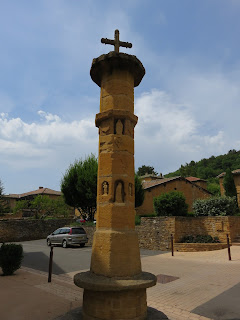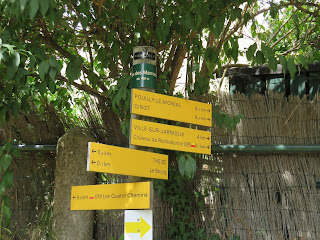Mindful of the current record-breaking heatwave and "orange alert," and not wanting to be stuck under the 40 degree Celsius sun for hours, our short randonnée will take us from the Salle Pluraliste (now a fancy name for "Public Parking Lot") up through the town, past the Castle, and up into the woods behind where we can find the Clos des Cadoles, a Madonna, and a telegraph tower. Not bad for a 3km hike.
From the parking lot, the signage is very clear, leading us up towards the church and castle. There is no point giving street names, because, like in many other villages, all the streets have the same name (in this case, Le Bourg).
We intend to stop at the church first, but at the Le Bourg Randonnée signpost, we notice the Hotel de la Feuillée still serving lunch on their patio. Since it is almost 2pm, we ask if it is too late to get served lunch, and are pleased to be told it's not a problem. Colin is still tasting foie gras from our trip to Bagnols, so he orders a Salade Gourmande, which comes topped with -- what else -- fois gras. I order the lunch special, which is a salmon salad for appetizer, grenouilles as the main, and a cheese plate for dessert.
The salmon comes topped with a gigantic wedge of butter. I'm not sure what I am supposed to do with it, so I eat around it. On this hot day, my panaché really hits the spot. The grenouilles come with home fried potatoes, but both are drowning in butter, which sounds like a good thing, but is not. I eat the top few, which are coated in yummy garlic, but I leave most of them on the plate so I will have room for my cheese plate, which is excellent. I note that there are four different cheeses, and feel good about my cheese choices at Bagnols. ;) Before leaving, I pop into the washroom, and am disconcerted by not being able to unlock the door after I am done. I am not sure how the restaurant staff will be able to free me from this small windowless room if I can't open the deadbolt. I struggle with it for a couple long minutes, then finally succeed in freeing myself by wrapping my skirt around the handle to get a better grip. Stepping out, one of the men from the kitchen is standing outside the washroom door, also looking quite worried. He must have heard me struggling and, like me, not really looking forward to breaking down the door to get me out.
This "new" church is supposed to have beautiful statues and images of the Guichard d'Oingt family. Unfortunately, the inner door is closed today, and we don't get to see inside. We only get to see the antechamber between the outer and inner front doors, which has a bas relief and some lovely stained glass.
A sign tells us that this 12-13th century Roman-style church used to be the old castle chapel. It was expanded in the 16th century to include four Gothic style chapels. Later, this church was completely abandoned, and actually used as storage for agricultural products! It was restored by youth volunteers sometime during or after the 1970s and served as the city church while the new church (the one we had just visited) was being built. Then, all the liturgical objects were taken from this church and put into the new church. Even the bells are taken, and a sad little school-bell like bell sits on top today.
By fluke, it is holding a two-day temporary art exhibition while we are passing through. There are paintings and collages by Hélène Vervialle, drawings and sculptures by Dominique Tavernier, and ceramics by Chantal Ferroussier. There is also live musical accompaniment by an accordion and a guitar-like instrument duo on the nave. They seem very happy every time someone walks in. I am not sure if we are allowed to photograph the art, so I just take one quick overview shot of the church. You can visit the links above to get an idea of their artwork.
We continue onward towards the castle. The homes on the street are so perfect, look like they belong in some kind of Disney film about France.
We reach the Chateau Rochebonne, but are distracted by the gorgeous view it faces.
The Castle Rochebonne was originally built in the 13-14th century, but was destroyed in the Hundred Years War to prevent the English from gaining control of it. It was rebuilt in the 15th century and improved upon until the 17th century. I decide that since I am now accustomed to castle living, this castle would suit me quite nicely, and claim ownership.
Perhaps it is "art day" in Theizé, but there is yet another art exhibition taking place inside the castle. There is art displayed in every room, and while some areas of the castle are cordoned off, we can still see through the glass to remnants of an older era of the castle, like winding staircases and cellars that are not longer in use. I take many photos, but none really turn out. We tour around and are greeted by the curator, who schmoozes us as honored guests and tells us that there will soon be wine served in the next room. We wonder if we have accidentally wandered into an invitation-only event. (The internet later tells us we have walked into the Vernissage, or preview of the show before the official opening.) We take our leave just as the official stuff is starting, and head out into the woods, where we tend to feel more comfortable anyway. ;)
The Chateau de Rochebonne signpost is right outside the castle, and points us towards Bois de Chassagne. The road begins by following a beautiful stone wall on the left, leaving the right open to the beautiful views over the countryside. Then the pavement ends and we enter the woods.

We pass a fork in the road and keep left. At the next fork, the signpost for Bois de Chassagne points us to the leftmost fork again, towards Les Quatre Chemins. The trail along this section gets a little rocky and somewhat difficult to navigate. We take it slow, grateful for the shade of the trees.
At the Les Quatre Chemins signpost, we again stay left, following it back towards Theizé. I've been super impressed with the signage on this route. It's been the clearest we've ever walked.
About half way to Theizé, we reach the Clos des Cadoles. The Cadoles (known locally as Cabanes/Cabins) are little stone huts on the sides of vineyards. They look ancient, but they are actually only from the 18-19th century. They were built as simple shelters and storerooms for people working on the vineyards. Some just needed temporary shelter, e.g. from a rainstorm, but others lived far from the fields in which they worked, and actually lived in these huts for periods of time. We have seen a few other Cadoles in fields on our various randonnées, but these are the first that we can actually approach and enter ourselves.
I am so impressed with the dry-stone masonry of these little huts. There is no mortar holding the stones together; they are all meticulously placed according to their shape. The first hut is still in perfect condition, and contains a niche that I assume is for a fire.
The second hut has a cross embedded into the outside roof, and the remains of some kind of loft inside. The inside of this hut is a little worse for wear, and stones are falling out of place in the fire nook and inside the window. Someone has propped up the window frame and adjoining inner wall with pieces of wood, causing me to back out more quickly than I would have otherwise.
The wall that runs along both huts seems to be the North side of a square enclosure. I am not sure what it was originally used for. Perhaps livestock or gardens? Today the enclosure is overgrown with weeds. There are narrow rocky trails that lead around the entire enclosure. We take the one to the right, but we can easily see the one to the left would bring us to the same place on the South side of the enclosure.
Heading farther down the rocky path towards Theizé, we find a sign describing the Cadoles and the telegraph tower.
We can't seem to find the tower, despite wandering along side trails a couple of times. What we do find is the Madonna, dated 1943. She has a strange metallic halo with an antenna that runs down her back and into the ground. Is THIS the telegraph tower?? Or is the little antenna supposed to protect the statue from lightening strikes? A look at the map tells us we have somehow completely missed the telegraph tower.
The path deteriorates even more as we approach Theizé. We struggle on the steep rocky incline. This would be extremely difficult for anyone with any mobility or balance issues. It cruelly passes a yard with a large swimming pool, which mocks us in the hot sun.
We pass the Old Church and descend an alley staircase to Impasse de la Voute, whose outline of a door in the solid stone wall makes me laugh, "Yep! That's an impasse alright!" until I realize the sign is referring to the vaulted alley to the left of the sign. I walk into it, noting the red and yellow randonnée flag, and the door for a Psychologist's office hidden in the shadows right smack dab in the middle of the archway. I conjure up embarrassed clients furtively glancing to the left and right before darting into the tunnel in the dead of night.
We exit the town at the roundabout facing the cemetery, turn left and follow Highway D96 back to the parking lot. By now we're ready for the second shower of the day, and return back to the gite to cool off and have "cheese time."






















































No comments:
Post a Comment